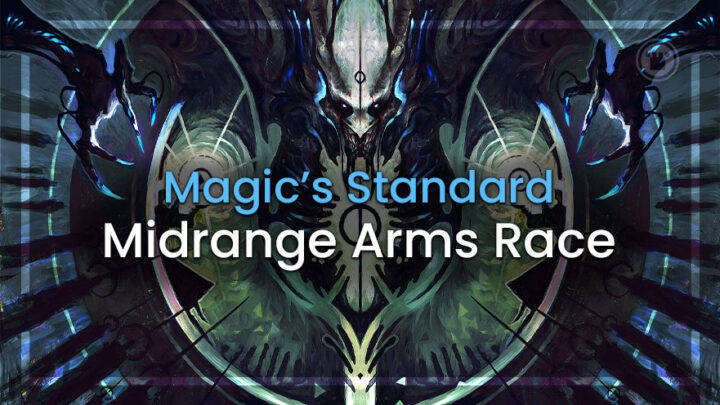When Phyrexia: All Will be One released, it looked as if Grixis Midrange was not only going to be the de facto Midrange deck, but also the best deck in Standard. Yet Standard is as cyclical as every constructed, competitive format, which has resulted in what is often referred to as the Midrange arms race.
This occurs when the default best thing to be playing is a strong Midrange deck, which beats up on smaller Midrange and Aggro decks. Then players realize they can exploit the existing Midrange deck by going from Aggro decks to bigger Midrange decks in an effort to outmuscle the original, winning strategy.
As for why we’re bringing this up now, all eyes are on the upcoming Regional Championship in San Diego this weekend. As the culmination of the cycle, it will show us the final form of Phyrexia: All Will Be One Standard as it has evolved throughout the past few months. But before that, let’s look at the full history.
ANZ Super Series Season 1, Cycle 2 Finals (March 3)
In the first round of this Regional Championship cycle, Grixis decks looked similar to this. Maxing out on main deck Reckoner Bankbuster wasn’t uncommon because the goal was to beat the mirror match, which was common since many players believed this was the best deck. This thought pattern also led players to register zero copies of Cut Down for game one, simply because it isn’t a valuable card in the mirror.
Sheoldred, the Apocalypse is in the conversation for the best card in Standard, except if you’re playing nothing but Grixis mirrors (because it eats a Go For the Throat or an Invoke Despair without doing much for its four mana investment). It was common to only see one or two copies of Sheoldred in the 75, often riding the bench in the sideboard.
As we move forward in time, we will see that building Midrange decks just to beat the Midrange mirror is a recipe to lose to players who show up ready to attack.
2Champions Cup Final Cycle2 (March 4)
As a matter of fact, during the same weekend there was another SEA Regional Championship. This one happened to see Selesnya Toxic take the tournament by storm.
The prevailing explanation is that while Grixis is inherently good against the creature decks, without access to Cut Down (and relying on Go For the Throat), decks like Selesnya Toxic can set up without needing to worry about much.
Furthermore, Skrelv is a strong card against Grixis, which often requires the Grixis player to deal with it before more threatening creatures. If Go For the Throat is your primary removal spell, answering the Skrelv, and therefore other creatures, is much more difficult.
Grixis also has a notable weakness to enchantments with Invoke Despair as their only answer. Selesnya Toxic exploited this by playing four copies of Skrelv’s Hive and Wedding Announcement, both of which produce tokens, minimizing the impact of individual removal spells. Midrange decks, specifically Grixis, needed to adapt.
Esper Legends can be built in a couple of ways. There’s a more aggressive version, shown here featuring Adeline, Resplendent Cathar, and a slightly more controlling version.
Given that most decks weren’t packing much cheap removal at the time, this more aggressive build was a good call. Yet even with the aggressive slant, Esper occupied a space in the metagame that was bigger than Selesnya Toxic and Mono Red but smaller than Grixis and Mono White.
Occupying the space where Go For the Throat was unreliable because of Skrelv, but being too big to fold to Brotherhood’s End put Esper in a unique position to dominate, and it did. Standard had a new top dog and the rest of the format would need to adjust.
F2F Tour Championship – Vancouver Cycle 2
Mono White started gaining traction, as it was good against both Esper and Grixis. The arms race had continued to develop with Mono White vying to go over the top of the black decks, attempting to cement its place as the best Midrange deck in Standard.
Sporting the full four copies of both Field of Ruin and Demolition Field lets Mono White disrupt the already shaky mana of both Esper and Grixis while having a clean mana base themselves. Sticky threats like Sanctuary Warden, Serra Paragon and The Eternal Wanderer give other interactive decks fits.
Mono White wasn’t without weakness. Selesnya Toxic easily gets underneath the bigger threats of Mono White. Also, Farewell is a good answer, but getting to six mana against a deck like Selesnya Toxic or Esper Legends isn’t guaranteed. There were more Regional Championships to come, and Standard certainly wasn’t done evolving.
Legacy European Championship Naples (March 11)
The following week, we saw Grixis decks look more like the one above, sporting four copies of Cut Down to be better positioned against Esper Legends and Selesnya Aggro. Additional copies of Brotherhood’s End in the sideboard further bolstered the matchup against the aggro decks. Grixis has finally been built in a way that beats up the smaller creature decks like they were thought to originally.
While those matchups improved, Mono White was still a problem. Grixis was maxing out on Invoke Despair, which was their best chance at dealing with Mono White. However this plan was tenuous at best given the current plan for Mono White was to destroy Grixis’ lands as often as possible, making it hard to cast a 1BBBB spell.
F2F Tour Championship – Ottawa (March 25)
In Ottawa, we saw the next advancement in the Standard, Midrange arms race: Rakdos. The way Rakdos solved its mana issues against Mono White was to simply cut blue and play a much cleaner mana base.
Field of Ruin loses a lot of its allure against a deck with 11 basic lands. But cutting blue meant Rakdos lost access to Make Disappear, Negate and Disdainful Stroke — some of which were valuable tools against Mono White. However, those cards were more for handling the Atraxa Reanimator decks that had since fallen off due to the success of the Aggro decks.
Without access to counters, Rakdos needed a new plan against Mono White. Loading up on Reckoner Bankbuster, Invoke Despair and Gix’s Command, all of which are strong options in the matchup.
Another benefit to pivoting is most of your lands come into play untapped, which is less true for Grixis. That allows for two things. First is a more aggressive slant, and second is the ability to interact earlier. Being able to play Cut Down or Duress on turn one without having to figure out where you can fit a tap land into the curve later on is a subtle but noticeable benefit.
The full set of Razorlash Transmogrant is another powerful component against Grixis, unless they move to more copies of Graveyard Trespasser and Flame-Blessed Bolt. While Mono White is more adept at exiting Transmogrant than Grixis, it still serves as another aggressive two mana creature to help force them onto the back foot.
End Step
The question is where does the arms race lead us for San Diego this weekend? I suspect we’ll see more copies of Rakdos and fewer copies of Grixis than we have in previous weeks.
However, I expect Mono White will drop some Field effects in favor of more Roadside Reliquary, given the fact that more players are swapping to Rakdos. Razorlash Transmogrant may also see a decline as the black, Midrange decks adjust for it, and Rakdos may go bigger with Archfiend of Dross. Only time will tell.
I’ll be battling it out in San Diego this weekend, so feel free to stop and say hello! Otherwise, you can always find me on Twitter @RappaciousOne for questions, comments or feedback. Until next week, best of luck and remember your basic lands!

Michael Rapp is a Modern specialist who favors Thoughtseize decks. Magic sates his desire for competition and constant improvement.

